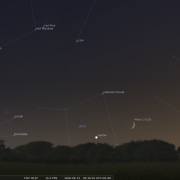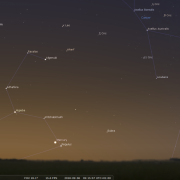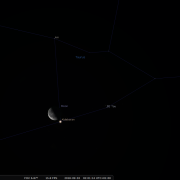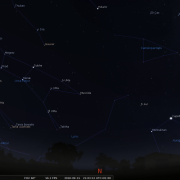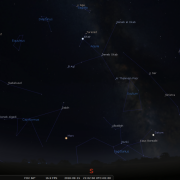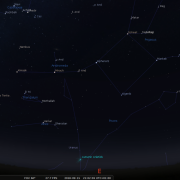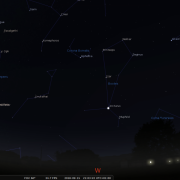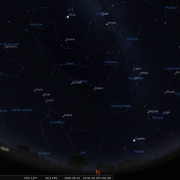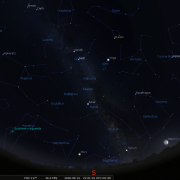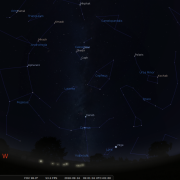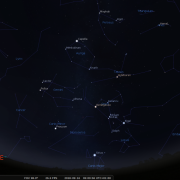In this month's Sky Notes:
Planetary Skylights
 After several months dominating the Western twilight, Venus will finally be lost during the first week or so of September, setting by 20:00h. Look for a conspicuous ‘star’ very low to the NW horizon.
After several months dominating the Western twilight, Venus will finally be lost during the first week or so of September, setting by 20:00h. Look for a conspicuous ‘star’ very low to the NW horizon.
 Jupiter is also nearing the end of its evening apparition, just about staying above the horizon all month, but becomes increasingly difficult to spot from midmonth, setting by 20:00h. It will however still be worth observing for the first week or so, visible low in the SW twilight sky. On the 13th a waxing crescent moon sits upper right.
Jupiter is also nearing the end of its evening apparition, just about staying above the horizon all month, but becomes increasingly difficult to spot from midmonth, setting by 20:00h. It will however still be worth observing for the first week or so, visible low in the SW twilight sky. On the 13th a waxing crescent moon sits upper right.
 Saturn is now ideally placed for observation as twilight deepens, visible all month relatively low down above the S-SW horizon. The rings are visible in any modest scope, but an aperture of 4” or more is needed to clearly define the major ring ‘gaps’ such as the Cassini division. Above all steady seeing is required, that and patience at the eyepiece. Look for Titan; Saturn’s largest moon, visible as a speck of light nearby the disk. Our moon lies very close by on 17th.
Saturn is now ideally placed for observation as twilight deepens, visible all month relatively low down above the S-SW horizon. The rings are visible in any modest scope, but an aperture of 4” or more is needed to clearly define the major ring ‘gaps’ such as the Cassini division. Above all steady seeing is required, that and patience at the eyepiece. Look for Titan; Saturn’s largest moon, visible as a speck of light nearby the disk. Our moon lies very close by on 17th.
 Mars resides centre stage low above the south horizon, a conspicuous fiery presence to the naked eye. It is a pity that for this opposition the red planet sits well below the ecliptic, which is itself always quite low during our summer evenings. Being so low we look at Mars through our dense, turbulent air, causing the image to ‘boil’ in the eyepiece; however those fleeting glimpses of the Martian surface are worth the wait. Look for the polar caps and some darker markings. The moon resides above right on the 19th.
Mars resides centre stage low above the south horizon, a conspicuous fiery presence to the naked eye. It is a pity that for this opposition the red planet sits well below the ecliptic, which is itself always quite low during our summer evenings. Being so low we look at Mars through our dense, turbulent air, causing the image to ‘boil’ in the eyepiece; however those fleeting glimpses of the Martian surface are worth the wait. Look for the polar caps and some darker markings. The moon resides above right on the 19th.
 Finally, Mercury may be found in the dawn sky for the first 10 days of September, look for it just left of due east, within a ‘fist’ height of the horizon. On the 6th Mercury joins Regulus (mercury lies to the left ) Then on the 8th an extremely thin crescent moon lies upper right with Regulus in the middle and Mercury lower left. You will need to observe around 05:10-05:25h.
Finally, Mercury may be found in the dawn sky for the first 10 days of September, look for it just left of due east, within a ‘fist’ height of the horizon. On the 6th Mercury joins Regulus (mercury lies to the left ) Then on the 8th an extremely thin crescent moon lies upper right with Regulus in the middle and Mercury lower left. You will need to observe around 05:10-05:25h.
 On the 3rd around 2am a waning crescent Moon passes fractionally above Aldebaran in Taurus.
On the 3rd around 2am a waning crescent Moon passes fractionally above Aldebaran in Taurus.
Meteors

There are no major noteworthy meteor showers in September; however you may spot a few Piscids which have two peaks: the 8th and the 21st. Rates are low, only 6 or 7 per hour at best, barely more than sporadic levels. As with all meteor showers early morning viewing will be best.
The Autumnal Equinox
According to astronomical convention autumn officially commences in the northern hemisphere around September 21st the date of the Autumnal Equinox. This year however autumn is a little late with the ‘equinox’ not occurring until September 23rd when Earth finally arrives at ‘third base’ on its journey around the Sun.

Harvest scene (Image credit: Johannes Plenio from Münich in Germany)
For the second time in the year neither northern nor southern hemispheres are inclined toward the Sun, and across the planet hours of daylight and darkness are equal. From our perspective the Sun re-crosses the celestial equator and with each passing day arcs lower in the sky as our hemisphere tilts away from the Sun.
September 2018 Sky Charts
|
Looking North
Mid-September - 21:00h |
Looking South |
|
Looking East
Mid-September - 21:00h |
Looking West
Mid-September - 21:00h |
|
Northern Aspect
Mid-September - 21:00h |
Southern Aspect
Mid-September - 21:00h |
| North-West Aspect (Early) Mid-September - 05:00h |
South-East Aspect (Early) Mid-September - 05:00h |
Additional Image Credits:
- Planets and Comets where not otherwise mentioned: NASA
- Sky Charts: Stellarium Software
- Log in to post comments

